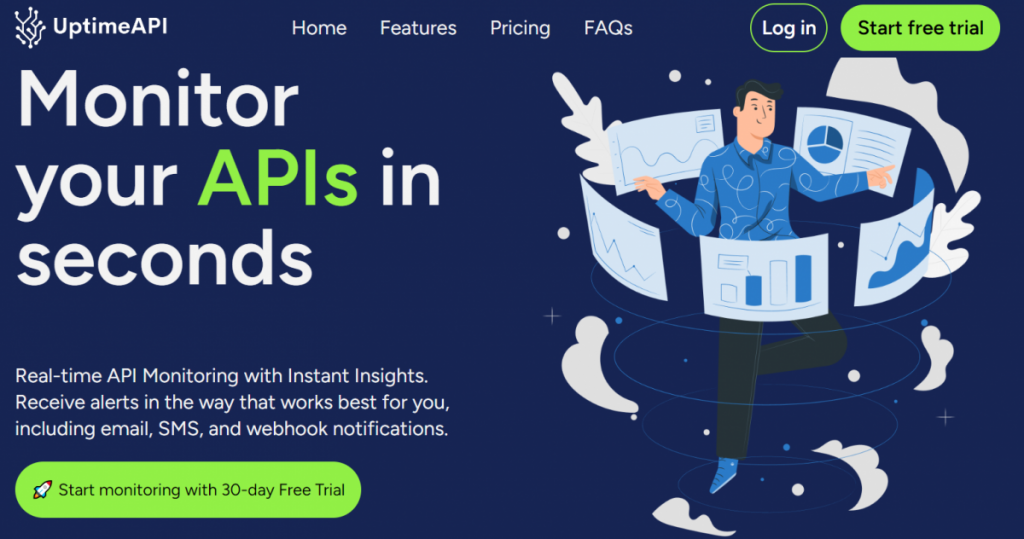In the ever-evolving landscape of software development, the reliable functioning of APIs is pivotal for the success of applications. Monitoring and ensuring the availability of APIs is made seamless with UptimeAPI. In this article, we will explore the significance of API usage, the integration process of UptimeAPI into your project, and gain insights into the API responses that empower developers to keep their projects robust and reliable.
The Significance of API Usage
1. Ensuring API Reliability

API reliability is paramount for applications to deliver consistent and seamless user experiences. By actively monitoring API usage, developers can identify potential issues, optimize performance, and ensure uninterrupted service.
2. Proactive Issue Identification
Monitoring API usage allows developers to proactively identify and address issues before they impact end-users. By receiving real-time alerts, teams can swiftly respond to downtime, slow response times, or other performance issues.
3. Optimizing Performance
Understanding how APIs are used in real-time provides valuable insights for optimizing performance. By analyzing usage patterns, developers can fine-tune their APIs to meet the specific needs of their applications and users.
Integrating UptimeAPI into Your Project

Read More: Company profile APIUsage Cases
1. Sign Up for UptimeAPI Account
Start by signing up for an account on the UptimeAPI website. The registration process is straightforward and provides you with access to the UptimeAPI dashboard.
2. Access the Dashboard
Once logged in, navigate to the UptimeAPI dashboard. Here, you will find a user-friendly interface that allows you to manage and monitor your API endpoints.
3. Add API Endpoints
Click on the “Add Endpoint” button to start monitoring your API. Input the necessary details, including the API endpoint URL and any specific parameters required for monitoring.
4. Customize Monitoring Preferences
Tailor your monitoring preferences to suit the specific needs of your project. Customize alert conditions, choose notification channels, and set up performance metrics to receive the most relevant insights.
5. Integration with Your Project
UptimeAPI provides seamless integration with various programming languages and frameworks. Refer to the comprehensive documentation available on the UptimeAPI website to easily integrate it into your project.
API Responses: Decoding UptimeAPI Notifications
Understanding the API responses generated by UptimeAPI is crucial for effective monitoring. Let’s explore the various responses that developers may encounter during API usage.
1. Healthy Response
A healthy API response signifies that the monitored endpoint is operational and responsive. UptimeAPI signals this with a success status code, typically in the 2xx range.
{
“status”: “success”,
“message”: “API endpoint is reachable.”,
“timestamp”: “2024-01-17T12:00:00Z”
}
2. Failed Response
A failed API response indicates potential issues with the API endpoint. This could result from slow response times or intermittent connectivity problems.
{
“status”: “failed”,
“message”: “API endpoint is experiencing intermittent connectivity issues.”,
“timestamp”: “2024-01-17T12:05:00Z”
}
3. Downtime Alert
UptimeAPI generates downtime alerts when an API endpoint experiences extended periods of unavailability. This is crucial information for developers to address issues promptly.
{
“alert”: “downtime”,
“message”: “API endpoint has been down for 15 minutes.”,
“timestamp”: “2024-01-17T12:15:00Z”
}
Making the Most of UptimeAPI in Your Project
1. Real-Time Monitoring
Leverage UptimeAPI’s real-time monitoring capabilities to stay informed about the health and performance of your API endpoints. Instantly receive alerts and notifications when issues arise.
2. Performance Optimization
Utilize UptimeAPI’s performance metrics to gain insights into the response times and overall performance of your APIs. Identify areas for improvement and optimize your APIs for enhanced efficiency.
3. Customizable Alerts
Take advantage of UptimeAPI’s customizable alert system. Tailor alerts to your preferences, ensuring that you are promptly notified of any deviations from expected API behavior.
Conclusion: Enhance Your Project with UptimeAPI
API usage is a critical aspect of modern software development, and ensuring the reliability and performance of your APIs is essential. UptimeAPI emerges as a valuable tool, seamlessly integrating into your projects to provide real-time monitoring and actionable insights. By understanding the nuances of API responses and leveraging the features offered by UptimeAPI, developers can enhance the robustness and reliability of their projects. Add UptimeAPI to your project today and empower yourself with the tools needed to keep your APIs performing at their best. Stay connected, stay informed, and elevate your project with UptimeAPI.

